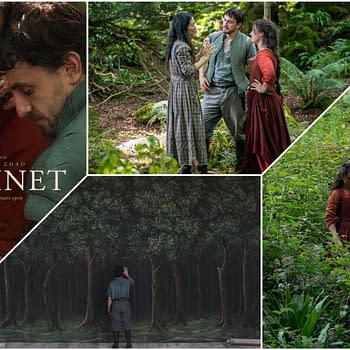Posted in: Movies | Tagged: Al Feldstein, carol tilley, Comics, comics history, Diagram for Delinquents, documentary film, entertainment, film, Frederic Wertham, Robert Emmons Jr., the Comics Code
Robert Emmons Talks Fredric Wertham And His New Documentary Diagram For Delinquents
By Nikolai Fomich
[Diagram for Delinquents]
Robert A. Emmons Jr., documentary filmmaker, Rutgers professor and lifelong comic book reader, has tackled in his new documentary Diagram for Delinquents the most hated man in comic book history – Dr. Fredric Wertham. Wertham's legacy needs no introduction, but the man himself may be another story. Though we vilify him for his fanatical demonization of our beloved art form, Wertham was far more than the cartoonish villain we remember him to be, as Emmons and other experts discussed at San Diego Comic-Con's "Sixty Years of Seduction" panel. Emmons' film puts Wertham in his context, examining the social and cultural forces that led to the great comic book scare of the 1950's. Having known Robert for a few years at Rutgers University, I have followed this film's development closely, and am thrilled it is now available to comic fans. I spoke with Robert about his new film (available here) and his changing understanding of that tumultuous period.
Nikolai Fomich: I'll begin by asking the question that's the most basic – yet also the most complicated: who was Fredric Wertham?
Robert A. Emmons Jr: In a way, I wanted to make this film in an effort to visually answer the question, "Who was Fredric Wertham?" I know who I thought he was, and who most comic readers thought he was, but after I read a few key texts like Bart Beaty's Fredric Wertham and the Critique of Mass Culture, my image of Wertham began to grow complicated. Wertham was a German born psychiatrist who came to the U.S. in the early 1920's. His early career was spent working at institutions researching and treating mental health patients. This work led to an even greater interest in the impact of media on society, particularly violent media and violent behavior. In his countless hours of work with children he noticed something he found alarming. That all the troubled children he was seeing read these violent crime comic books. What he failed to understand though, was that over 90% of all children at that time read comics! He was only seeing suffering and troubled children and missing the countless others that had positive experiences with comic books and had no issues of juvenile delinquency or mental distress.
NF: Before you began making this documentary, what was your opinion of Wertham and the controversy surrounding comics during that period? How did those ideas change over the course of this research?
RAEJ: Before making this film, I thought what most people thought: Wertham ruined comics! It was a wild time in comic book history. America was in a state of panic. People were burning comic books, the Senate was holding hearings on what to do about them, and the loudest voices against comics were making all the major headlines. In reality, the whole period is so nuanced and complicated that you need to see the entire picture, not just the sensational parts. I call Diagram for Delinquents not so much a biography of Wertham, but a zeitgeist film, one that represents the cultural climate of America during a particular period. One must really see all that was happening around comics to understand why the industry was forced to make dramatic changes.
What changed most for me, through making the film, was [my] understanding of Wertham as a historical figure. He is a man largely vilified, but in so many ways he had done so much good for all the right reasons, mostly in an effort to protect the well-being of children. But don't get me wrong. The man did not like comics at all. He saw no redeeming qualities in them. He thought they would never have anything to offer and only did harm. His goal was to have the government ban the sale of them to anyone under 16.
[Comic Book Burning]
NF: Had you read EC Comics or other horror comics from the 1950's before beginning work on Diagram for Delinquents? What did you think of them?
RAEJ: I've read many EC comics. Before making the film I had been a big fan of EC's Weird Science, Weird Fantasy, and Weird Science-Fantasy comics and I own all of those in the bound Cochran editions. I hadn't read much of their horror comics until I started the research phase of the film. There is some really strange and wonderful stuff in those EC horror books. And the art? It's like no other in the period. It's so distinct, it's gorgeous. Each artist has his own style which perfectly aligns with the content. EC paid careful attention to that.
[EC Comics]
But I'd have to say, while I can very much appreciate and enjoy them, I can't quite imagine my 10 and 9 year olds reading and seeing some of that stuff, especially when they were a little younger. So in a way, I can empathize with some of the furor over what was being read by children. The main argument here though – just like it is today [with] video games – is whose responsibility it is [to control] what my children are exposed to. I am a strong believer in free speech, so in art and media, it's ultimately my responsibility to educate and watch over what my children are experiencing. The various media providers can help in that with rating systems, but only in an effort to aid consumers. This is where the difficult argument of censorship enters the fray.
NF: When did your interest in Wertham's work and the comic book scare of the 1950's begin? What about the topic fascinated you enough to make this documentary?
RAEJ: Like many comic book readers, Wertham's name was always a footnote of interest. If you've seen any documentary about comics they all pretty much contain the same two-minute sequence about Wertham and the Senate Subcommittee Hearings on Comic Books that resulted in the establishing of The Comics Code. As a filmmaker that has made a few historical documentaries, I had a feeling that there had to be more to the story. It wasn't until August of 2010, when the Library of Congress opened Wertham's files to the public that I thought about trying to visually tell Wertham's story.
NF: What did you learn that surprised you the most?
RAEJ: I think what surprised me most was how little I actually knew about Wertham. You get so wrapped up in the mythology of historical figures that when you dedicate the time to learning more it's really enlightening. I mean, here's a man whose writings and testimony were used as evidence in the ending of segregation in the U.S. In 1966 Wertham's book A Sign for Cain was published. In it, Wertham calls for an end to human violence. He wants to eradicate it. He believes it can be done. To me, that is a bold, powerful, and altruistic call for action. It's things like this that really complicate the man of legend.
NF: What is impressive about Diagram for Delinquents is your balanced portrayal of Fredric Wertham – how you took a nuanced look at a man utterly vilified in the comic book industry. How much blame do you think Wertham really deserves for the decline of comics books?
RAEJ: It's tough to play a blame game on what happened with comics in this transitional period. I think the film really takes lengths to establish just how complicated this question is. What we can say is after 1954 everything changed in comic books. Horror and crime comics were gone. EC was essentially forced out of the business of publishing comics. Readership severely declined. The Golden Age had ended. Did Wertham cause this? No. To make such a simple statement would be as silly as saying comic books caused juvenile delinquency. Was Wertham the leading voice in the anti-comics crusade? Arguably, yes. Did he play a major role in forcing the comic book industry to police itself? Yes. But as far as the decline of comics as a creative and mass media force, one needs to examine the medium itself and its new competitors, namely, television.
NF: One of the people you interview in your documentary is Professor Carol L. Tilley, author of the article "Seducing the Innocent." In it, she produced compelling evidence demonstrating that Wertham fabricated and manipulated his data. Do you think there is any validity at all in anything Wertham had to say about comic books and juvenile delinquency?
RAEJ: Let me go on record – I am jealous of Carol Tilley! I'm glad she's featured in the film! I went through those archives, just like she did, but she found it! She uncovered what many had believed for years – that Wertham manipulated his findings to create the most compelling anti-comics narrative he could, that being Seduction of the Innocent. It wasn't a surprise, I think, but it was the confirmation that many had wanted for a long time.
Seduction of the Innocent is a peculiar book. It's an alarmist text for sure. At times, its statements seem so hyperbolic I found myself laughing out loud while reading it. Do I think Wertham's ideas on comic book have any validity? That's a difficult question. I think the more important discussion is the still ongoing one about the correlation between media and its impact on society. How does media influence us? We don't have all the answers, but we know that media and its messages have an impact. The argument is, is it a direct causation or something else? Media certainly informs us, but I'm not sure if it's a causal relationship. It's an informative one. That is still a valid discussion. Wertham was contributing to that discussion, however misguided or evangelical it was at times.
NF: Though Diagram for Delinquents centers around Wertham, the film is as much about the hysteria over juvenile delinquency in the early 1950's. Author Bradford W. Wright states in the documentary that "in ways that maybe were more complicated than what Wertham made it out to be, [comics] were changing the way children thought about things. They couldn't help but do so. That's what popular culture does, it changes what people think of as normal…" Beyond the kind of simplistic sensationalism Wertham popularized, how did comic books actually affect youth of the period?
RAEJ: The way I see it… Comic books were an early, liberating mass medium for children. They had a tremendous impact on the imagination of a nation. People love stories. Stories are how we make sense of the world. Comic books were a new and exciting medium that told stories. Comics were something that the children of America could call their own. That's why readers are collectors. These treasures have such an impact on our desire for stories that we hold on to them.
NF: What do you think can be learned from that whole ordeal?
RAEJ: I think the single thing to be learned is that no story is simple. No comic book is simple. No history is simple. And understanding Wertham is not simple. Being media literate is understanding that notion. It takes work.
[Al Feldstein]
NF: This documentary is dedicated to the late Al Feldstein, a pioneer of comic book illustration, editing, and scripting. Any final words on Al?
RAEJ: Being with Al was the highlight of making this film. He was generous beyond words. And what I would say about him is this – he was man who loved and cherished the medium as much as the fans who loved and cherished his work.
Thanks to Robert Emmons for taking the time to talk about his latest film! Follow him on Twitter @raemmonsjr
Nikolai Fomich is a teacher and writer in Philadelphia. Follow him @brokenquiver


















